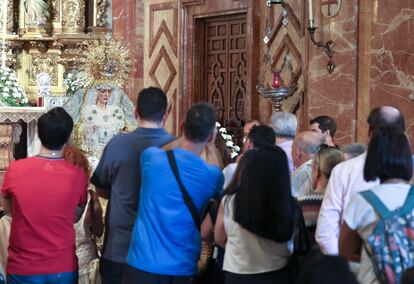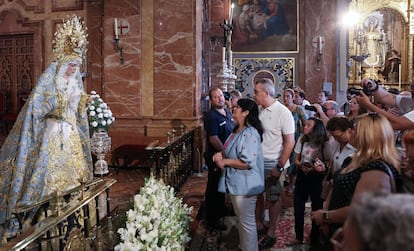Outrage and disbelief at the restoration of the Macarena in Seville: "Leave it as it was."

“This is not my Virgin. She looks a little more like the one that was here a week ago, and certainly nothing like the one they put up this Saturday, but she's still not my Macarena; her expression is different. What they've done to the Virgin is unjust.” That was Paqui Fernández's opinion this Sunday after leaving the Basilica of La Macarena to see the results of a controversial intervention ordered by the Brotherhood. This intervention has sparked widespread anger among devotees of this image, and among the people of Seville, by extension. They are outraged that the changes have affected her expression, to the point that, for many, her face bears nothing to do with the one that has made La Macarena an icon of Seville. However, the indignation was far more subdued than that expressed by the faithful who had come to the church the day before. In 24 hours, and in the face of the uproar and pressure generated on social media and the departure of the faithful from the site, the Virgin underwent two surgeries to replace her eyelashes (at midday) and restore the redder tone to her cheeks (during the night).
"The Virgin of the Macarena belongs to the people of Seville, not to the Brotherhood. It's a personal possession, and that's why it's very delicate to touch anything." This is how Juan Manuel Miñarro, a religious image maker, restorer, retired professor of sculpture from the Faculty of Fine Arts at the University of Seville, and member of the Royal Academy of Fine Arts of Saint Elizabeth of Hungary, conveys the impact that the intervention on the Virgin has had on the city, which goes far beyond the technical or artistic circumstances behind the retouching of the face and other elements of the image, which have deteriorated greatly over time, exposure to candle smoke, and displays during worship and processions.
This circumstance is precisely what led the Brotherhood to agree to "a maintenance and conservation action" on this carving, which was carried out during the second week of June, for a period of four days in the Basilica itself by a team from the University of Seville led by the Professor of Conservation and Restoration of Works of Art at the University of Seville, Francisco Arquillo Torres, who had submitted a preliminary report on the general condition of the image in which it was stated that it was good and did not require extensive or immediate intervention, as reported by the Brotherhood on November 10. In the 1980s, Arquillo began to work on restorations of this 17th-century carving attributed to the circle of Pedro Roldán, and, according to recent studies, to his daughter La Roldana.

The conservation work was supposed to focus, according to what the brothers were told, on "superficial elements," but all the restorers and image-makers consulted by this newspaper agree that the result—especially the one shown last Saturday—with its ill-fitting and very long eyelashes and an overly pale face, transcended the mere tasks of a "conservation intervention," becoming clearly a restoration project. "Cleaning the polychrome is much more than a mere conservation task," warns Pedro Manzano, a specialist in the conservation and restoration of works of art. "When you clean an image, you are already restoring it, and that requires more than a week of work," warns another prestigious restorer who asks not to be named because he does not know the full details of the reports that led the Brotherhood to commission the maintenance work and what it actually entailed. "A restoration requires at least three or four months, not one week, and a team of multidisciplinary professionals behind it," he adds.

“The Virgin is not the same,” Miñarro concedes. Two aspects caught the most attention when the image was reinstalled in the Basilica last Saturday: the eyelashes and the disappearance of the characteristic reddish patina that surrounds the Macarena's gaze and gives her face that characteristic expression of tiredness. “The first impression was that the eyelashes were not correctly positioned and that they were too long. Eyelashes are what give expressiveness to a devotional face, and her expression had changed,” explains restorer Ana Cordero. “The degree of cleanliness of the face was also surprising,” she adds.
Opacity
Precisely these two aspects were the ones the Brotherhood retouched in two more express restorations in the following 24 hours. On Saturday at noon, the church was closed to replace the eyelashes—“to correct an undesired effect caused by the eyelashes replaced during the procedure,” the Brotherhood explained in a tweet. At night, work was done on the face again, restoring some of the reddish color around the eyes and cheeks. “The Brotherhood was extremely hasty in returning the image to worship. They should have studied it first, analyzing the impact it would have on the public. The Brotherhood faced this situation with great trepidation,” Miñarro maintains.
All the experts also question the fact that in less than 24 hours the Brotherhood reworked a project it itself had commissioned and defended. "That undermines the credibility of that prior work. The Brotherhood has not been clear; it has not established a working methodology," indicates the curator, who prefers to remain anonymous. "They will have to provide explanations," adds Cordero. This newspaper has tried unsuccessfully to contact those responsible for obtaining their opinion. This secrecy, both before and after, regarding the content of the work carried out on the Virgin and how it was carried out is another of the main criticisms raised by the experts consulted. In this regard, the Brotherhood has not clarified whether the retouching carried out during the night from Saturday to Sunday was done by curators from Arquillo's team or by others.
“When we're undertaking a restoration, and especially in the case of La Macarena, which is a universal image, a committee should have been created with experts from all sectors of the art world to determine how to approach the work and what to do,” says Manzano. José Antonio Navarro Arteaga, one of Seville's most important contemporary religious image makers, introduces another controversial element among sacred art specialists: who should lead the restoration of Sevillian images. “The team has to be multidisciplinary, but it should be led by religious image makers, who are the ones who give the images that mystique they should have; restorers are dedicated to their conservation,” he points out.
"The team that worked on the maintenance should present a restoration report, with a before and after," adds Miñarro, who, however, points out that the Macarena has had other interventions and other sets of eyelashes in the past, "depending on fashion," and that each modification, "even when her outfit is changed," sparks controversy.
“Even if it looks more like her, this is still not the Macarena I have at home, in my religious images. Let them take her away for as long as they have to, but leave her as she was,” Lucía Redondo maintained on Sunday afternoon, leaving the Basilica, while the group of friends accompanying her nodded in agreement. “When work is done on an image, it has to remain exactly the same,” Navarro Arteaga confirms. The sculptor concedes that the Virgin needed work—“the rust on the varnish had to be removed”—and that with the last-minute fixes, “the image is very close to what it was before,” but he emphasizes the haste on the part of those responsible and the lack of transparency. “The Virgin can return to her natural state, but that takes time,” he warns.
The organizers of a demonstration on social media to protest the results of the intervention have appealed to the restoration of this natural state and dissatisfaction with the Brotherhood's lack of clarity regarding the work carried out on one of the city's most recognizable images. "It's as if someone had had cosmetic surgery," says María, standing with Lucía Redondo.
EL PAÍS



%3Aformat(jpg)%3Aquality(99)%3Awatermark(f.elconfidencial.com%2Ffile%2Fbae%2Feea%2Ffde%2Fbaeeeafde1b3229287b0c008f7602058.png%2C0%2C275%2C1)%2Ff.elconfidencial.com%2Foriginal%2F079%2Fe1a%2F3c3%2F079e1a3c31d014c16510935c28eca988.jpg&w=3840&q=100)

